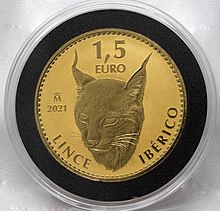
The Krugerrand is a South African coin, first minted on 3 July 1967 to help market South African gold and produced by Rand Refinery and the South African Mint. The name is a compound of Paul Kruger, the former President of the South African Republic, and rand, the South African unit of currency. On the reverse side of the Krugerrand is a pronking springbok, South Africa's national animal.

The standard circulating coinage of the United Kingdom, British Crown Dependencies and British Overseas Territories is denominated in pennies and pounds sterling, and ranges in value from one penny sterling to two pounds. Since decimalisation, on 15 February 1971, the pound has been divided into 100 (new) pence. Before decimalisation, twelve pence made a shilling, and twenty shillings made a pound.

The Mexican peso is the currency of Mexico. Modern peso and dollar currencies have a common origin in the 16th–19th century Spanish dollar, most continuing to use its sign, "$".

The five pound British gold coin, or quintuple sovereign, has a nominal value of five pounds sterling. It has been struck intermittently since 1820, though as a circulation coin only in 1887, 1893 and 1902. Through most of its history, it has depicted, on its reverse, Benedetto Pistrucci's portrayal of St George and the Dragon, which has traditionally been used on the sovereign, or one-pound gold coin.

The Royal Canadian Mint is the mint of Canada and a Crown corporation, operating under the Royal Canadian Mint Act. The shares of the Mint are held in trust for the Crown in right of Canada.

Britannia coins are British bullion coins issued by the Royal Mint in gold since 1987, in silver since 1997, and in platinum since 2018. The reverse of the coin patterns feature various depictions of Britannia, a feminine personification of the United Kingdom while the obverse features a monarch effigy with the legend around it.
The Canadian Silver Maple Leaf is a silver bullion coin that is issued annually by the Government of Canada since 1988. It is produced by the Royal Canadian Mint.

The American Buffalo, also known as a gold buffalo, is a 24-karat bullion coin first offered for sale by the United States Mint in 2006. The coin follows the design of the Indian Head nickel and has gained its nickname from the American Bison on the reverse side of the design. This was the first time the United States Government minted pure (.9999) 24-karat gold coins for the public. The coin contains one-troy ounce (31.1g) of pure gold and has a legal tender (face) value of US$50. Due to a combination of the coin's popularity and the increase in the price of gold, the coin's value has increased considerably. The initial 2006 U.S. Mint price of the proof coin was $800. In 2007 the price was $899.95, $1,410 in 2009, and $2,010 in 2011.
The Canadian Platinum Maple Leaf is the official bullion platinum coin of Canada. First issued by the Royal Canadian Mint in 1988, it was available until 2002 in five different denominations, all of which are marked as containing .9995 pure platinum. The bullion coin was partly reintroduced in 2009 in the form of the 1 troy ounce denomination in .9999 purity, featuring a new portrait of Queen Elizabeth II on the obverse. The coins have legal tender status in Canada, but as is often the case with bullion coins, the face values of these coins is lower than the market price of the material they are made from.
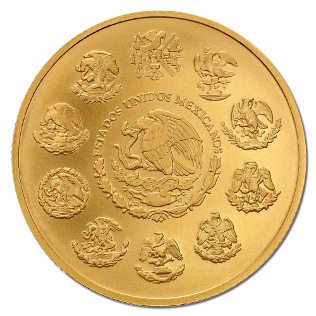
The Libertad coins are silver and gold bullion coins originating from Mexico and minted by the La Casa de Moneda de México. The Mexican Mint was established in 1535 and is the oldest mint in the Americas. The modern coins contain 99.9% silver or gold and are available in various sizes. Both metal coins have undergone a design change. In 1989, 3,500 1⁄4 ounce Libertad platinum coins were produced. Libertads are devoid of face value, yet are legal tender, still accepted as currency and guaranteed by Banco de México based on the market value of its gold or silver content.
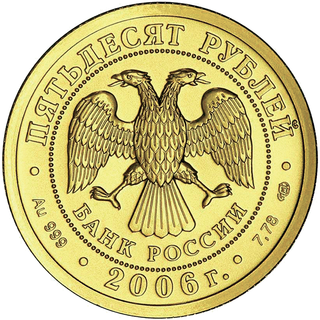
The Russian George the Victorious is a bullion coin issued in gold and silver by the Central Bank of Russia. Mintage began in 2006 with quarter-troy ounce (7.78g) gold coins with a face value of 50 rubles and later in 2009 a one-troy ounce silver coin was introduced with a face value of 3 rubles. Since then, tenth, half, and one-troy ounce gold coins have been minted.
The Vera Valor is a dual digital and physical gold currency of one troy ounce with no face value other than that of one ounce of "four nine" purity fine gold. The reverse side of the coin is particular by its embedded QR code which allows for digital liquidity.
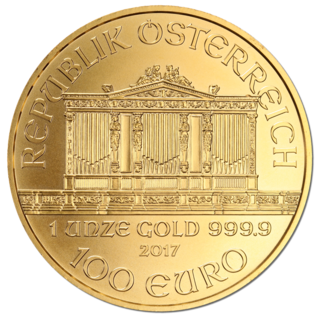
The Vienna Philharmonic, often shortened to Philharmonic, is a bullion coin of gold, silver, or platinum produced by the Austrian Mint. The coin is named for the Vienna Philharmonic orchestra, which inspired the design of both sides. It was introduced in 1989 as a one-troy ounce (ozt), gold coin with a face value of 2,000 Austrian schillings. It is generally one of the world's best selling bullion coins. In 2002, with the adoption of the euro currency, the nominal value of the one-ounce coin was changed to 100 euros. In 2008, the Mint introduced a one-ounce silver version of the coin with a nominal value of 1.50 euros. The silver coin is also one of the top selling bullion coins, ranked third in 2013. In 2016, the mint introduced a one ounce platinum coin with a face value of 100 euros.

The Noah's Ark silver coins are Armenian bullion coins issued since 2011. They are available in various sizes with a fine weight between 1⁄4 ounce and 5 kg in silver of 999/1000 fineness. The 1 troy oz. coin has a nominal value of 500 Drams and is legal tender in Armenia. The coin is produced by the Leipziger Edelmetallverarbeitungs GmbH, an affiliated company of Geiger Edelmetalle. The motif of the coin remains constant, similar to other bullion coins such as the Canadian Silver Maple Leaf, the Vienna Philharmonic, and the American Silver Eagle.
The one hundred pound coin (£100) is a commemorative denomination of sterling coinage. Issued for the first time by the Royal Mint in 2015 and sold at face value, £100 coins hold legal tender status but are intended as collectors' items and are not found in general circulation. As of 1 November 2021, the silver content of each coin was worth about £35.

The history of ancient Iberian coinage begins as early as the fifth century BC, but widespread minting and circulation in the Iberian peninsula did not begin until late in the third century, during the Second Punic War. Civic coinages - emissions made by individual cities at their own volition - continued under the first two and a half centuries of Roman control until ending in the mid-first century AD. Some non-civic coins were minted on behalf of Roman emperors during this period and continued to be minted after the cessation of the civic coinages. After the cessation of the civic coinages, these Imperial coins were the only coins minted in Iberia until the coins of the Suebi and Visigoths.
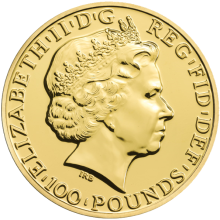
The Lunar or Shēngxiào (生肖) coin series is a collection of British coins issued by the Royal Mint featuring the Chinese zodiac in celebration of Chinese New Year. First issued in 2014, the series has been minted in varying denominations of silver and gold as both bullion and proof.

The double sovereign is a gold coin of the United Kingdom with a nominal value of two pounds sterling (£2). Rarely issued in the first century and a half after its debut in 1820, it never had a significant presence in circulation. It is now a collector and bullion coin, and has been struck most years since 1980. It features the reigning monarch on its obverse and, most often, Benedetto Pistrucci's depiction of Saint George and the Dragon on the reverse.
The American Liberty high relief gold coin is a one-ounce gold bullion coin issued by the United States Mint since 2015. This coin was the first 100 dollar gold coin to be issued by the US Mint.

Manx Angels are gold or silver bullion coins distributed by the Isle of Man and minted by private companies. The Isle of Man is not part of the United Kingdom. It is a Crown dependency and thus can mint its own coins. The coin depicts Archangel Michael slaying a dragon. The silver coins have not been minted every year, but have an erratic schedule. Angels are legal tender but they do not have a fixed face value; instead, like the Krugerrand or Mexico's Libertad, they are legal tender to the value of their precious metal content.

